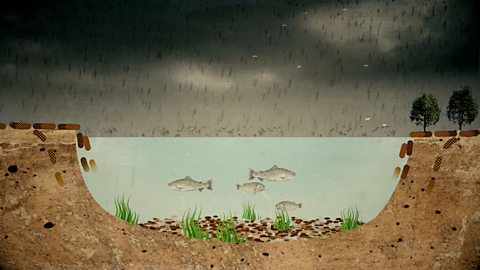Paul:
My journey has brought me to Devon, famed for custard, cream teas and the mighty River Tamar. This is a river that is facing its fair share of problems from agriculture as well as sewage pollution. But there are a couple of fellas who think they have a solution to the issues affecting our rivers. And it might not be one you'd expect.
Derek:
Nice to meet you. How are you doing?
Paul:
Derek. Tay.
Tay:
Nice to meet you.
Paul:
Ex-intensive farmer Derek and ecologist Tay are part of a growing rewilding movement.
Derek:
Basically, we have a few animals that are still domestic animals, we have some Highland cattle here, there are a few unusual ones like water buffalo. And we have wild beavers living on our farm.
Paul:
Right. Rewilding divides opinion. The idea is that giving land back over to nature can restore degraded landscapes and habitats, including our waterways. But many believe that land is needed for rearing livestock and growing crops to meet our food needs. Despite the controversy, Derek and Tay are committed to the cause. That was a fairly dramatic drive through the savanna.
Derek:
The safari. The animals here are all here to perform a function.
So the digging, we see in front of us is wild boar in here somewhere.
The buffalo are in here to create big wallows that are full of insects like dragonflies and beetles, and the cattle are here to graze in a random way, as are the ponies, so the whole idea is we are creating a landscape using these animals that is fit to offer living space for a range of wild creatures. That's what we're doing.
Paul:
But at the pinnacle of what you're doing, I think is, the beavers. Would that be correct?
Derek:
Yeah. I've been involved with, with the reintroduction of the beaver for about a quarter of a century.
Paul:
Because they're quite controversial, aren't they? The reintroduction has got it's detractors, as well as it's proponents like you.
Derek:
They're not controversial with anybody that thinks. It is the genesis of life. Next to humans, elephants, beavers are the third most impactful species on the planet.
Paul:
They're not on human level, I've never seen one pilot a Concorde. But they are builders and they change the environment in a way not many other species do.
Derek:
It's the great water gardener, that makes living space for all other life. Bare in mind they're very, very friendly but bouncy.
Paul:
Now, if you haven't quite guessed it already, Derek is bonkers about beavers. And loose in this twenty acre plot, there's a colony of his little furry friends. it's quite magical in here, isn't it?
Derek:
It's beautiful. Here's a patch here, but the bark's been removed. Can you see all those slots?
Paul:
Yeah
Derek:
That's the tooth marks coming through.
Paul:
So is this a beaver's playground?
Derek:
Yeah. There's a nice example of their handiwork down there on the floor.
Paul:
That's like, that's like a dumbbell isn't it?
Tay:
Yep, go on.
Paul:
That's enough. There you go Tay.
Tay:
Don't want to strain yourself.
Paul:
No.
Beavers have been keeping waterways healthy across the globe for millennia. They were once native to Britain, but became extinct in the 16th century. But now, they are back in Devon.
Derek:
So this is a beaver dam here. So it's-
Paul: What?
Derek:
What?
Paul:
I would never have that down as a beaver dam in a million years.
Derek:
That's what they naturally looked like, the beavers move a lot of plants and roots and they vegetate over and they're completely green in the light, so the structure you'd normally associate with is people standing next to something that's really dramatic, stark.
Maybe it's just been newly built.
But all those dams, in the end when they're not new any more, and when the mud takes and the plant roots take, they all look like this.
The dams are catching 80% of the silts that are coming off the land. If you're trapping the nitrates and phosphates, all that silt will be going into the streams, the rivers, and down into the sea, polluting the estuaries.
So the beavers are providing natural filter systems.
Paul:
Did you assess the quality of the water before reintroducing the beavers? Because surely they need fairly pristine conditions to thrive and survive or are they very hardy?
Tay:
Beavers, beavers are fine with whatever water. Um, certainly when they build their dams, they actually catch a lot of those pollutants, it kind of acts like a filter system.
Paul:
Great. So beavers one, everyone else nil, so far. Yeah?
Derek:
Pretty much.
Paul:
You're biased, you two. Come on.
Tay:
A little bit, a little bit maybe, yeah.
Paul:
Now, I didn't come all this way just to see some nibbled logs and muddy dams, I'm here to see a beaver. And, as dusk set in, I've been promised they'll come out and play. At least, that's the idea.
Derek:
Well, that, that's one lodge there in the middle and that's got a big pile of sticks and aquatic plants and everything else, which they build into huge stick nests. And where's the other one. Tay, then?
Tay:
Uh, it's just on the right. You can just about make out the top of the pile of big sticks with some purple loosestrife coming out the top.
Paul:
Is there any way we can lure them out? I could sing, perhaps?
Derek:
I really wouldn't do that actually, no I don't think that's going to be the way.
Tay:
I don't know that it would be you singing that would really bring them in.
Paul:
Turns out beavers are a bit shy. Orders are to keep quiet and wait. Bit like fishing, really.
Derek:
That's a baby, do you see it? They're so playful that their parents try and keep them together, and then they just, they just do their own thing.
Paul:
Like any good teenager. He looks bigger than the, he looks bigger than the other one but maybe hit's the same one.
Thankfully, they showed up at the end, they popped up, they beavered around. You've got fifteen seconds to sum up why we need more beavers.
Derek:
They produce life in great profusion. We can't sort this problem out, they and help us solve it.
Paul:
So you two, you're just beaver obsessed.
Even for an old cynic like me, the sight of a beaver swimming about is pretty special. But you need more than a few of them to solveour river problems.
And at the moment, that doesn't look like happening any time soon.
Paul visits River Tamar in Devon to hear about the growing beaver rewilding movement.
Rewilding aims to restore ecosystems by removing human control and letting nature back in to manage it. It is claimed that giving areas of land back to nature can help restore degraded landscapes and habitats, including waterways.
The charity, Rewilding Britain, defines rewilding as: “the large-scale restoration of ecosystems to the point where nature is allowed to take care of itself. Rewilding seeks to reinstate natural processes and, where appropriate, missing species – allowing them to shape the landscape and the habitats within.”
Beavers are natural river engineers and can alter the landscape in ways that are beneficial and attractive to a variety of wildlife, thus increasing biodiversity.
Beavers can slow the rate of river-flow through their dam-building and this can lessen the likelihood of flooding downstream.
Beavers’ natural river engineering can also act as an effective water filter.
The beaver-built dams on this stretch of the River Tamar, in Devon, are claimed to collect up to 80% of the silt in the river as it flows through, including the pollutants in it such as phosphates and nitrates from agricultural run-off and waste water systems releasing sewage upstream.
Beavers were once native to the UK as recently as 300-400 years ago, but they were hunted to extinction for their fur and their meat.
People have only recently realised the important role they can play in thriving and healthy ecosystems.
This video is part of UK rivers case studies, a series of clips taken from Paul Whitehouse: Our Troubled Rivers – available on BBC iPlayer.
Teacher Notes
Before watching the film:
- Using digital mapping software such as Digimaps, Arc GIS, or Google Maps, locate the source and mouth of the River Tamar on a map and identify some of the landscapes it passes through.
- To locate and use images of outstanding, natural beauty you could research, ‘Geography for Schools’ as the photographs will show a river flowing through settlements and agricultural land. Thus, implying that it is likely to be contaminated like many other rivers in the UK.
- Recap learning by asking students to make connections between river velocity, sediment transportation and pollutants and flooding downstream after peak flow.
- Establish with students what they know about beavers and tell them that it was a creature once native to this country before it became extinct.
During the film:
- You may wish to stop at relevant points during this short film to pose questions and check understanding or wait until the end. Useful questions might include:
- What kind of problems does the River Tamar face and why? (Agricultural run- off and sewage pollutants)
- How might beavers contribute to cleaner rivers and a healthier environment? (Engineering landscapes to be more diverse, attracting a variety of wildlife; reducing flooding, and filtering pollutants).
Following on from the film:
- Discuss students’ initial thoughts on the idea of rewilding beavers and whether it is useful or not in their opinion. Make a class list of pros and cons.
- Follow this up with a more sustained enquiry-led study of the impact beavers can have on landscapes, using a range of sources.
- Ask students to consider how this may come into conflict with the need to grow and produce food through farming activities and to create a case study and report with recommendations.
Curriculum Notes
All these short clips build on students’ understanding of human and environmental interactions and provide opportunities to practice geographical skills such as enquiry, mapping and fieldwork.
At KS3, students can learn more about how human and physical processes interact to influence and change landscapes, environments and the climate.
At KS4, the film supports understanding about fluvial environments, flooding hazards and climate change, environmental management and fieldwork investigation.
This clip could be used to support the delivery of geography to KS3 and KS4 students.
The film might also be used for example, to contribute to case studies about human interactions on fluvial environments (CCEA), the topic of managing rivers, resources and or landscapes appears in OCR, Edexcel, AQA, WJEC KS4/GCSE in England and Wales, CCEA GCSE in Northern Ireland and SQA National 4/5 in Scotland.
Further clips from Paul Whitehouse: Our Troubled Rivers
Water industry privatisation. video
A look at the background to the privatisation of ten regional water authorities in 1989.

River Wharfe and wastewater systems in the UK. video
Paul visits the River Wharfe in Ilkley, West Yorkshire to see how it is affected by pollution from sewage.
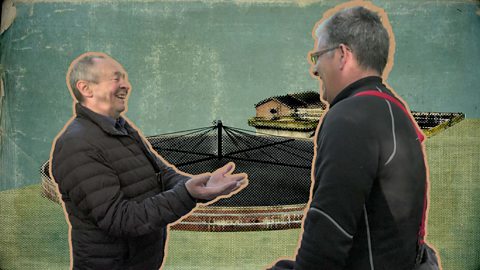
Lake Windermere eutrophication. video
Paul visits Lake Windermere to hear how tourists may be contributing to pollution levels.
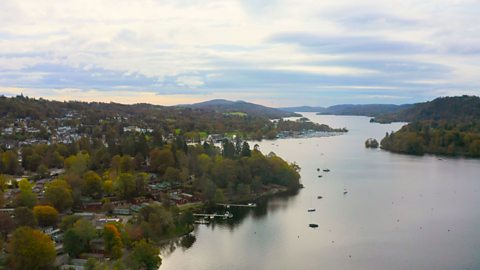
Pharmaceutical pollution in the River Clyde video
Paul visits the River Clyde in Glasgow to hear about pharmaceutical pollution and its consequences.
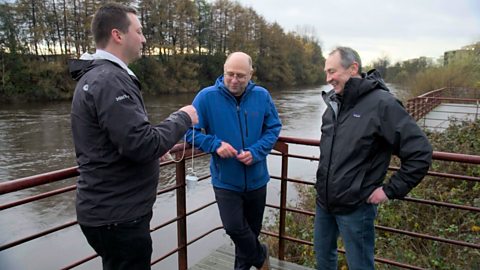
River monitoring and 're-wiggling' on the River Ribble. video
Paul visits the River Ribble in Lancashire to look at biodiversity monitoring and a project that is putting meanders back into the river.
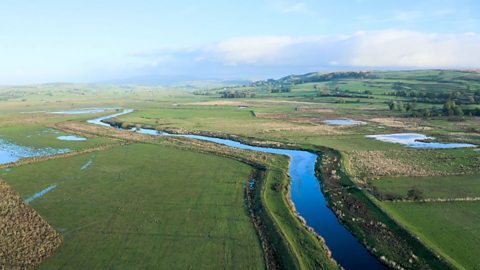
River Tame microplastic pollution. video
Paul learns about how microplastic pollution affects the River Tame in Greater Manchester.
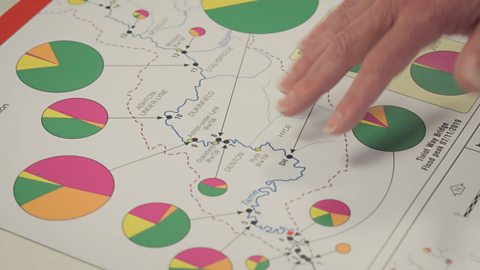
River Test and UK chalk streams. video
Paul visits Hampshire to look at a very rare habitat – England contains 85% of all chalk streams in the world.

River Thames Tideway project video
Paul visits the construction site of a 'super sewer' in London.
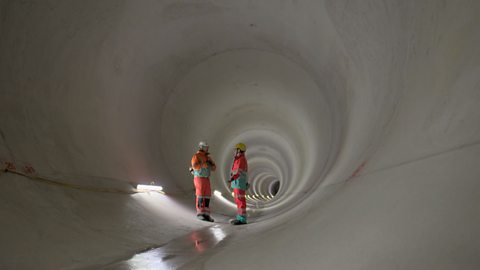
Intensive chicken farming and the River Wye video
Paul looks at how agricultural pollution is affecting the River Wye.
